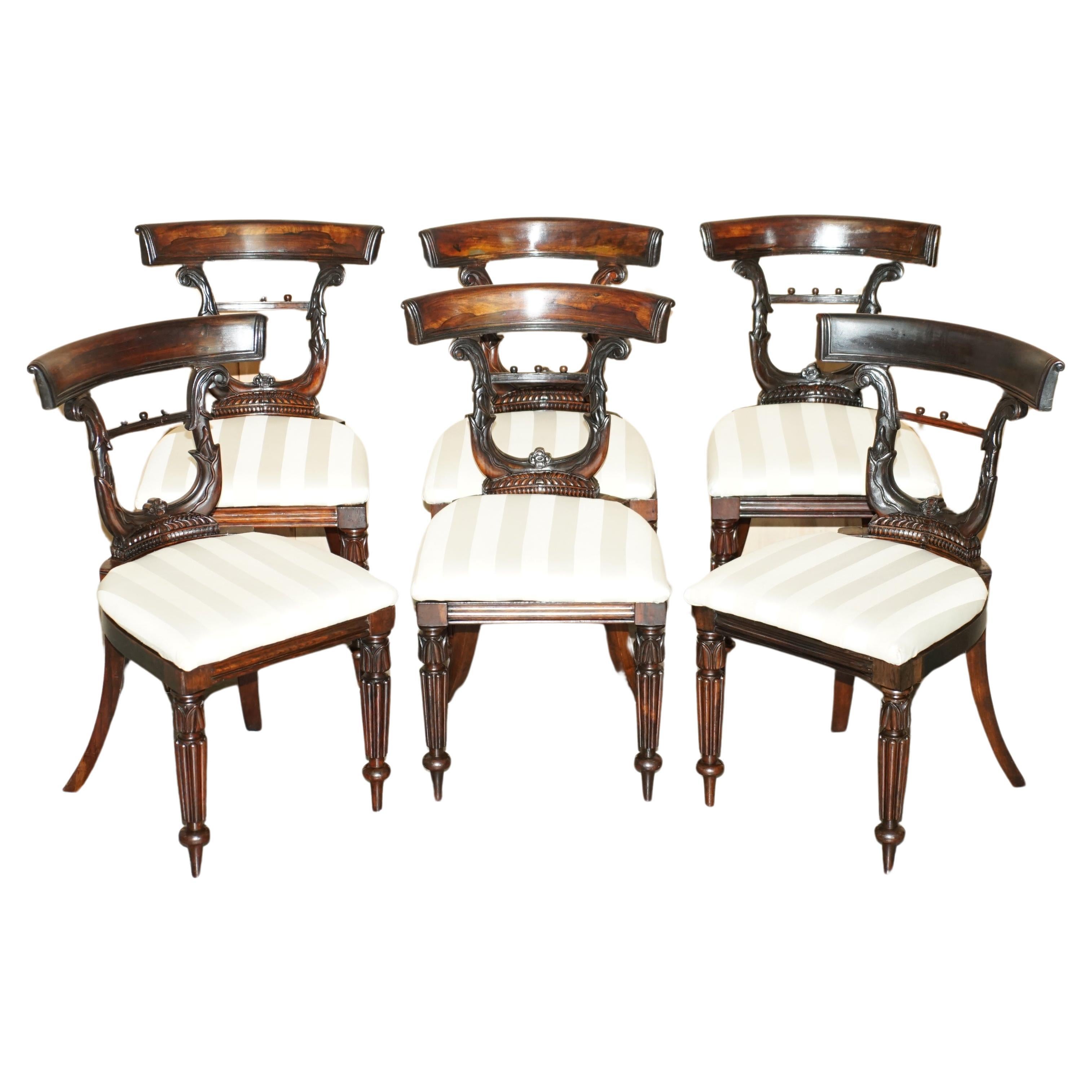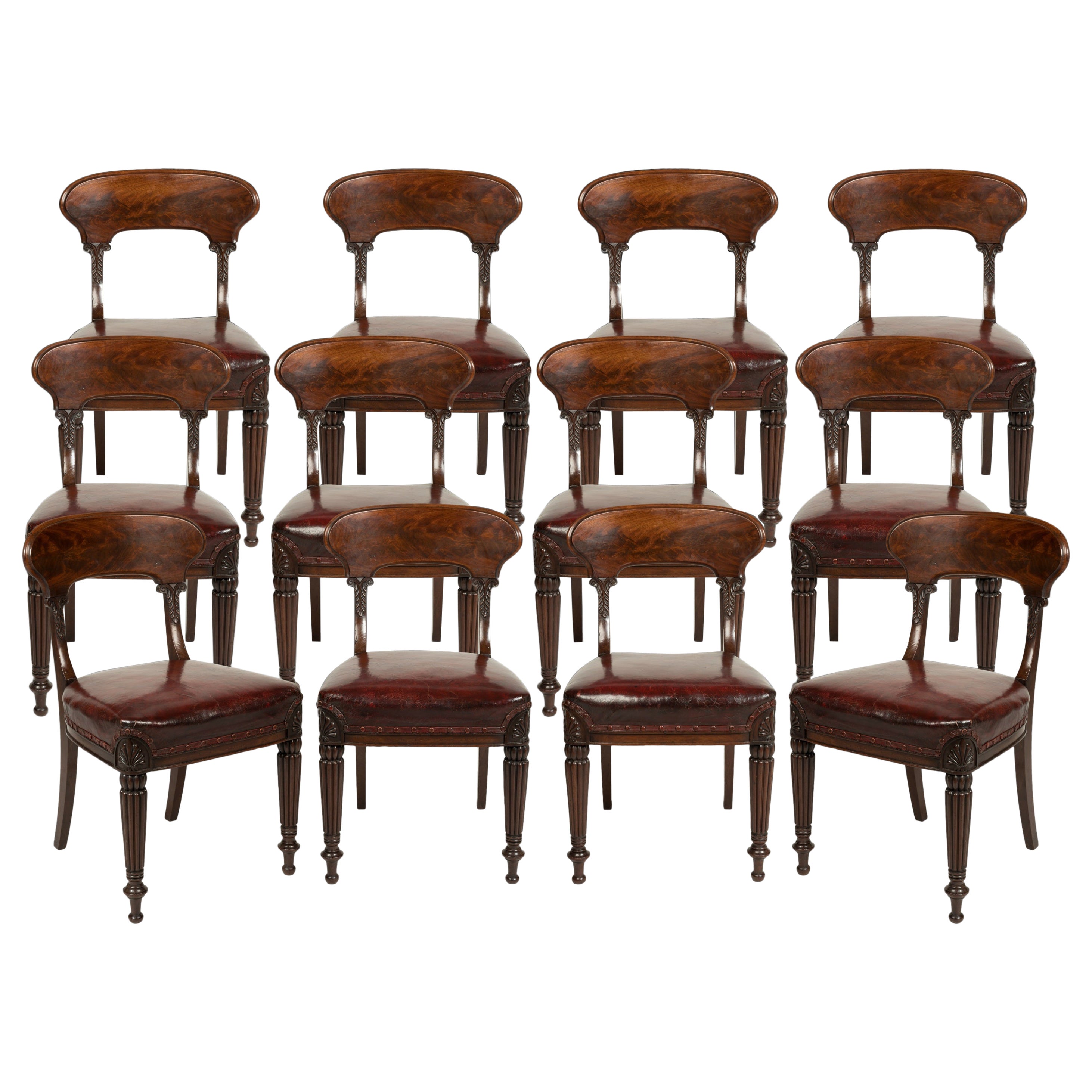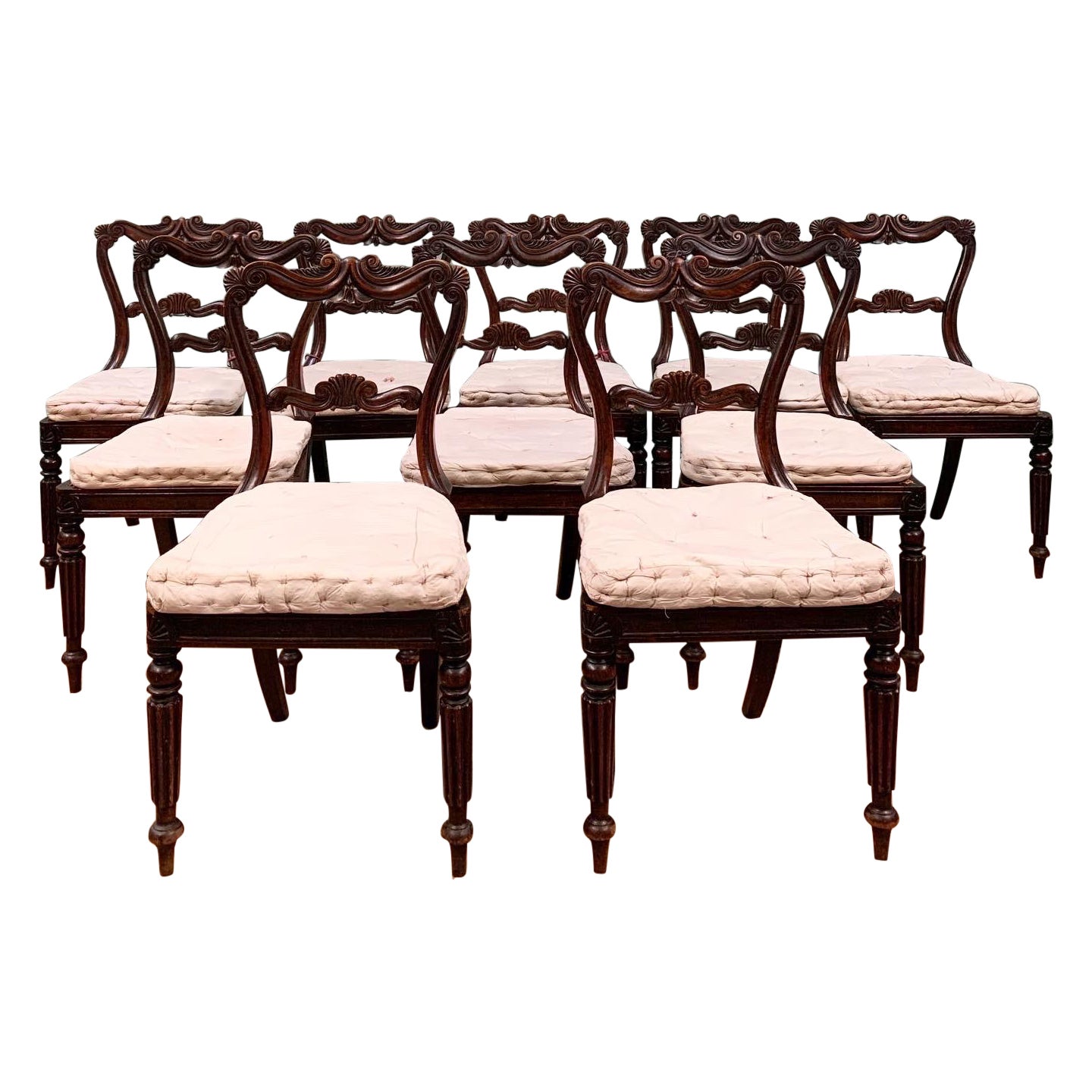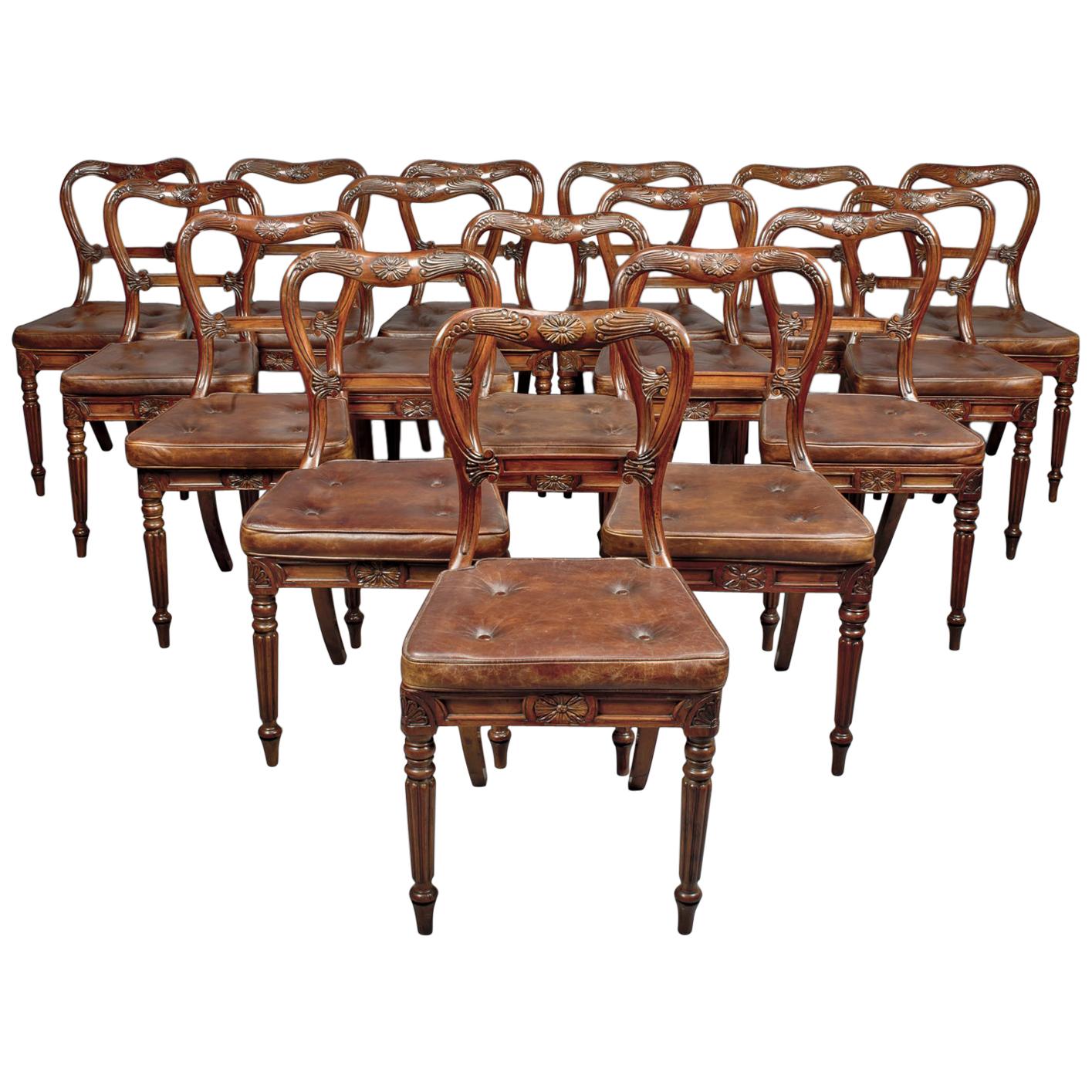Items Similar to Set of Six Regency Klismos Chairs, attributed to Gillows
Want more images or videos?
Request additional images or videos from the seller
1 of 16
Set of Six Regency Klismos Chairs, attributed to Gillows
About the Item
A very fine and elegant Regency period set of SIX 'Klismos' side chairs after designs by Thomas Hope, the manufacture attributed to Gillows. A pair of elbow chairs n-suite is available seperately.
England, circa 1810.
Why we like them
These superb quality, wonderfully stylish Klismos chairs correspond to a design published in Thomas Hope's ‘A Collection of Designs for Household Furniture and Interior Decoration' (1807), visible on the view of the Picture Gallery at the designer's own Duchess Street mansion in London. A particularly fine and rare design, very comfortable and of great scale and proportions, these super smart chairs will be a very chic addition to an eclectic or modern interior.
This design derives from Thomas Hope's Household Furniture and Interior Decoration, published in London in 1807, which drew inspiration from the ancient Greek and Roman examples, depicted on pottery, frescoes and marble reliefs.Hope’s designs were highly influential and inspired the work of other designers and makers including Gillows of Lancaster and London.
Attribution to Gillows
The chairs stamped E.WOOD to the underside, a feature characteristic of the Gillows workmen. Although unidentified, this is the name of the craftsman responsible for the making of these pieces.
A set of twenty-four open armchairs of this pattern were supplied by Gillows to Elizabeth Brooke (d.1809) in June 1803, for Mere Hall, Cheshire,and were later sold from there, Christie's house sale, 23 May 1994, lot 106 (£210,500). Dining chairs in the Small Dining-Room at Oulton Park, Cheshire share the same pattern back (illustrated in situ in C. Latham, In English Homes, London, 1908, vol.III, p.315).
- Attributed to:Gillows of Lancaster & London (Cabinetmaker)
- Similar to:Thomas Hope (Designer)
- Dimensions:Height: 33.08 in (84 cm)Width: 19.3 in (49 cm)Depth: 21.66 in (55 cm)Seat Height: 17.72 in (45 cm)
- Sold As:Set of 8
- Style:Regency (Of the Period)
- Materials and Techniques:
- Place of Origin:
- Period:
- Date of Manufacture:circa 1810
- Condition:Wear consistent with age and use. Superb condition, fully restored and highly polished. Upholstery is traditional, hand-stitched horsehair, coverings with minor signs of use. May be recovered in material of buyer's choice.
- Seller Location:Richmond, GB
- Reference Number:1stDibs: LU1781237530262
About the Seller
5.0
Gold Seller
These expertly vetted sellers are highly rated and consistently exceed customer expectations.
Established in 2014
1stDibs seller since 2016
212 sales on 1stDibs
Typical response time: <1 hour
Associations
LAPADA - The Association of Arts & Antiques Dealers
- ShippingRetrieving quote...Ships From: Richmond, United Kingdom
- Return PolicyA return for this item may be initiated within 7 days of delivery.
More From This SellerView All
- Pair of Regency Klismos Chairs, attributed to Gillows, Early 19th CenturyBy Gillows of Lancaster & LondonLocated in Richmond, LondonA very fine and elegant Regency period set of eight 'Klismos' chairs after designs by Thomas Hope, the manufacture attributed to Gillows. England, circa 1810. Ready for placement an...Category
Antique Early 19th Century English Regency Armchairs
MaterialsBrass
- Pair of Regency Painted Klismos ChairsBy Thomas HopeLocated in Richmond, LondonA fine pair of bronze-painted and gilt side chairs of Klismos form English, circa 1825. Why we like them A timeless Klismos design, bea...Category
Antique Early 19th Century English Regency Chairs
MaterialsWood, Upholstery
- Pair of Regency Klismos ChairsBy Gillows of Lancaster & LondonLocated in Richmond, LondonA very chic Regency period pair of 'Klismos' chairs with Greek key decoration to the backs, attributable to Gillows of Lancaster and London, England, circa 1805. Why we like them T...Category
Antique Early 19th Century English Regency Chairs
MaterialsUpholstery, Hardwood
- A Pair of Klismos Chairs, Attributed to George Oakley - Eight Chairs AvailableBy George OakleyLocated in Richmond, LondonAn exceptional pair of Regency period chairs, of well-shaped 'Klismos' outline and rare generous proportions, attributed to George Oakley of Bond Street. London, circa 1810. Four pairs available: to purchase a set 8 eight chairs, please, select quantity 4 pairs. Priced per pair. Why we like them: With its front legs unusually splayed in two dimensions, this elegant model is one the most sophisticated examples from the Regency period. Unusual in their form, subtle in ornamentation and outstanding in quality, these chairs display the decorative techniques of cabinetmaking, rather than joinery. The veneers and greek-key brass-inlays cover the seatrails and front legs joints, a highly unusual feature for chairs, that demonstrates the superb cabinetmaking skills of the craftsman or a high-end workshop origin. Attribution: Extremely rare with this 'double-splayed' form of front legs, deriving from the ancient Greek 'Klismos' seats, these chairs feature exquisite brass inlays throughout, and share similarities with a number of pieces of furniture traditionally associated with the oeuvre of George Oakley (1773-1840), one of the most prominent London cabinetmakers of the era. The distinctive scrolling foliage pattern of the inlays on the back tablets of these chairs is identical to those adorning the top of a spider-leg sofa table, illustrated in F. Collard, Regency Furniture, Woodbridge, 1987, p. 317, and in Mallett, The age of Matthew Boulton - Masterpieces of neo-classicism, London, 2000, pp. 112-113. This table belongs to a group of furniture firmly attributed to George Oakley and most likely originates from the same workshop as the present chairs. An identically decorated daybed, en-suite with the present chairs, is illustrated in the same Mallett's catalogue, pp. 94-95. A magnificent centre table, featuring the same set of inlays, certainly from the same workshop and possibly part of the same suite with the present chairs, was sold Christie's, New York, 29 January 1994, lot 342. An identical pair of chairs is illustrated in Ronald Phillips, Fine Antique English Furniture 2018, pp. 158-159. George Oakley: The firm of George Oakley produced stylish furniture in the Grecian taste during the decades spanning the turn of the 19th century, and was one of the pioneers of ‘Buhl’ inlay, a form of decoration that regained popularity during the early years of the Regency. Fashionable materials such as rosewood, mahogany and calamander were often used in Oakley's furniture, combined with inlays of satinwood and ebony, and brass stars and bands of metalwork. The high-class furniture made by George Oakley earned him a royal appointment and a contemporary reputation for fine craftsmanship. Visits by the royal family to Oakley's Bond St Showrooms are recorded in the Morning Chronicle of 1799. In May ‘the ROYAL FAMILY, with the PRINCE and PRINCESS of ORANGE did Mr. OAKLEY the honor of viewing his Printed Furniture...Category
Antique Early 19th Century English Regency Chairs
MaterialsBrass
- Pair of Regency Chairs, attributed to George BullockBy George BullockLocated in Richmond, LondonCollectors' choice - a very fine and rare Regency period pair of mahogany chairs, firmly attributed to George Bullock. England, circa 1815. Why we like them These superb quality, wo...Category
Antique Early 19th Century English Regency Chairs
MaterialsHardwood
- Set of Eight Elegant 19th Century Dining ChairsBy Gillows of Lancaster & LondonLocated in Richmond, LondonA superb quality set of eight dining chairs, after late 18th century designs by Gillows of Lancaster and London, the manufacture attributable to Gillow & Co. A pair of armchairs en-suite is available separately. English, circa 1880 Why we like them Wonderfully elegant model, looking very delicate but in fact unusually strong - the sign of a skilled craftsman. Interestingly, identical chairs can be seen on a painting by Walter Dendy Sadler (British, 1854-1923), The After Lunch Conversation, 1889, sold at Doyle, New York, 21 May 2024, lot 83. Design These chairs correspond to Gillows’ 'Garforth pattern', which first appeared in 1795 and was probably an adaptation of Georges Jacob's design of circa 1792 for Marie-Antoinette's dairy at Rambouillet. Gillows made the chairs not only in mahogany but also japanned and they appear to have been particularly popular among the genteel, professional and merchant classes in the north of England. In 1796 the Earl of Strafford purchased six white and green japanned chairs for Wentworth Woodhouse, and Sir William Gerard ordered thirty-six mahogany chairs for Garswood New Hall, Lancashire. While the design featured a round or 'compass-fronted' seat (see the set of twelve sold anonymously, Christie’s, London, 29 April 2010, lot 86, £46,850 including premium) they were also made with a more conventional square seat. A set of fourteen chairs of this pattern with square seats are illustrated in S. Stuart, Gillows of Lancaster and London 1730-1840, Woodbridge, 2008, p. 195, pl. 166. The design was adopted by the influential architect/designer Sir John Soane (d. 1837). He commissioned the set of twenty 'mahogany trellis chairs' for the Governor’s Room at The Bank, supplied in 1809 by the cabinet-maker David Bruce (d. 1823) of Aldersgate Street, London (see M. Jourdain, 'Early 19th-Century Furniture at the Bank of England’, Country Life, 3 October 1947, p. 676, fig. 2). Soane owned a pair of armchairs of the Bank design at his own home at Lincoln’s Inn Fields, now the Soane Museum, and adapted the design for a set of dining-chairs supplied by John Robins in 1821. Robins' invoice described these as 'trellis back chairs...Category
Antique Late 19th Century English Neoclassical Dining Room Chairs
MaterialsWood
You May Also Like
- SIX GILLOWS OF LANCASTER ATTRIBUTED ANTIQUE HARDWOOD REGENCY 1810 DINING CHAIRsBy Gillows of Lancaster & LondonLocated in GBRoyal House Antiques We are delighted to offer this important suite of museum quality, antique Colonial Gillows of Lancaster Attributed solid Rosewood dining chairs with ornately carved back splats Please note the delivery fee listed is just a guide and covers London only for the UK and local Europe for the rest of the world, if you are outside of this area please send me your address and I will provide you with an accurate quote Where to begin, if you’re looking at this listing then the chances are you know exactly how significant this suite is, Gillows of Lancaster & London was simply put, one of the most important furniture designers in the history of England, these chairs are the only Colonial examples I have ever seen and in Rosewood no less, they weigh roughly three times more than a standard dining chair of the same style and size, they are very substantial The chairs early 19th century circa 1810-1820, the carving is exquisitely executed and the chairs look sophisticated and elegant from all angles The suite has been sympathetically restored to include a deep clean, hand condition wax and hand polish, the seat covers have been left as they are, they are fine, the timber has a wonderfully aged patina that is honestly sublime Dimensions Height:- 81cm Width:- 45cm Depth:- 50cm Seat height:- 44cm Please note all measurements are taken at the widest point. Lot Essay These chairs are closely related to those in two recognised Chippendale commissions: Sir Gilbert Heathcote (d. 1785), 3rd Baronet for Normanton Hall, Rutland and William Crichton-Dalrymple, 5th Earl of Dumfries (4th Earl of Stair, 1699-1768) for Dumfries House, Ayrshire. THE RELATED CHAIRS The chairs are of identical decoration to the set of two armchairs and ten single chairs, circa 1765, formerly at Normanton Hall (1). In 1759, Sir Gilbert Heathcote (d. 1785), 3rd Baronet, succeeded to the vast inheritance established by his grandfather, also Gilbert, 1st Baronet (1652-1733), who was reputed to be ‘the richest commoner in England’ (2). The 3rd Baronet employed both Chippendale Senior and his son, Chippendale Junior, in the furnishing of his Palladian mansion, Normanton Hall in Rutland, and his London houses, 29 Grosvenor Square, London and Browne's House at North End, Fulham. Surviving Chippendale accounts, although incomplete, show that the firm was working periodically for members of the Heathcote family from 1768 to 1821. Most of the furniture listed in these accounts was intended for Browne’s House, although after 1798 when the family relinquished this residence some of the furniture was moved to Normanton Hall. The latter was sold in 1924, and any furniture not included in the Normanton Hall sale was taken to the Earl of Ancaster’s seat at Grimsthorpe Castle, Lincolnshire. Chippendale’s earliest invoice for Sir Gilbert Heathcote records the acquisition in 1768 of ‘6 India Back and arm chairs Japand to imitate the Bamboe’, signifying how the family embraced the highly fashionable chinoiserie taste. Although the Normanton chairs cannot be conclusively identified in the extant Chippendale accounts, their form and ornamentation led Christopher Gilbert to suggest that they were possibly by Chippendale (3). The set of four mahogany chairs at Dumfries House have nearly-identical pagoda-form cresting rails and identical terminals but differ in the arrangement of the 'Chinese' paling in the backs and side panels. Although no documentary evidence for the Dumfries chairs survives, in their execution and sophisticated carving of the toprails, they are extremely close to Chippendale’s hand. Another near-set of closely related chairs is at Saltram House, Devon, where Chippendale worked between 1771-2; these dates are based on payments in John Parker's cash account book, and probably do not reflect a true picture of the entire commission as Parker often paid tradesmen by banker's draft (4). Comprising two armchairs and seven single chairs, this set, circa 1765, is made of padouk, and has been described by the National Trust as ‘Chinese Export’ (5). The set was returned to Saltram in 1951 having been accepted by H.M. Treasury in lieu of full payment of Death Duty from the Executors of Edmund Robert Parker, 4th Earl of Morley (1877-1951). Some of the chairs are currently on display in ‘The Chinese Chippendale Bedroom’. A further set of four padouk chairs of the Saltram pattern was almost certainly at Kenwood House, London; some of these are recorded in 18th century inventories drawn up by Lord Mansfield. This set was removed to Scone Palace, Perth, prior to the auction at Kenwood in 1922, and subsequently sold from ‘Scone Palace and Blairquhan: The Selected Contents of Two Great Scottish Houses’, Christie’s, London, 24 May 2007, lot 298. Another pair of padouk chairs of this model sold ‘The Collection of Peggy and David Rockefeller’, Christie’s, New York, 10 May 2018, lot 647 ($193,750 inc. premium). THE DESIGN Conceived in the Chinese manner expounded by William and John Halfpenny in Rural Architecture in the Chinese Taste (1752), and Sir William Chambers in his Designs of Chinese Buildings, Furniture, Dresses, Machines and Utensils (1757), the pattern for this set of ‘Pagoda’ chairs relates to nine designs for ‘Chinese Chairs’ in the 1st edition of Chippendale’s Director (1754); the cabinet-maker describes these designs thus: Plates XXIII, XXIV and XXV are nine Chairs in the present Chinese manner, which I hope will improve that taste, or manner of work; it having yet never arrived to any perfection; doubtless it might be lost without feeling its beauty: as it admits of the greatest variety, I think it the most useful of any other. The sizes are all specified on the designs. The three last (No. XXV.) I hope will be well received, as there has been none like them yet made. The Georgian period witnessed the proliferation of such railed and pagoda-crested chairs in both the ‘picturesque’ Chinese tea pavilions of landscaped parks as well as in fashionable apartments hung with ‘India’ paper. The geometric ‘Chinese’ feet of these chairs are also found on a set of pedestals...Category
Antique 1810s English George III Dining Room Chairs
MaterialsHardwood
- Set of 12 Late Georgian Mahogany Dining Chairs attributed to GillowsBy Gillows of Lancaster & LondonLocated in London, GBA Fine set of Twelve George IV Dining Chairs Attributed to Gillows of London & Lancaster Constructed from flamed Cuban mahogany, with hand-car...Category
Antique 19th Century English George IV Dining Room Chairs
MaterialsLeather, Mahogany
- A Fine Set of Ten George IV Dining Chairs, attributed to GillowsBy Gillows of Lancaster & LondonLocated in London, GBA rarely available long set of ten faux rosewood dining chairs. The chair back with its elegant top rail , having abutting scroll corners below carved scallop shells is a design seen in Gillows Lancaster Estimate Sketch Books for 1823. Unupholstered horsehair squab cushions...Category
Antique Early 19th Century English George IV Dining Room Chairs
MaterialsCane, Beech
- Set of Eighteen Red Walnut Dining Chairs Attributed to Gillows, circa 1830By Gillows of Lancaster & LondonLocated in Brighton, West SussexA set of eighteen red walnut dining chairs attributed to Gillows. English, circa 1830. Each chair has a waisted balloon back, with incised foliage and panelled horizontal spla...Category
Antique Early 19th Century English Dining Room Chairs
MaterialsWalnut
- Pair of Regency Mahogany Hall Chairs by Gillows of LancasterBy Gillows of Lancaster & LondonLocated in London, GBA PAIR OF REGENCY MAHOGANY HALL CHAIRS ATTRIBUTED TO GILLOWS, c. 1815 For a related mahogany hall chair see Susan E Stuart, Gillows of LANCASTER and LONDON 1730-1840, Antique Coll...Category
Antique Early 19th Century English Regency Chairs
MaterialsMahogany
- Set Of 6 Early 19th Century English Regency Chairs Attributed To GillowsBy Gillows of Lancaster & LondonLocated in Dublin, IEA very fine set of 6 Regency dining chairs attributed to Gillows of Lancaster and London, having a quality figured top rail with a reeded edge and carved top supported by shaped reeded supports over foliate scrolled splats, drop-in seats with luxury velvet fabric upholstery standing on reeded tapering legs to the front and out swept back legs. Circa 1820 English Artists Biography: The Gillow family of cabinet makers and upholsters came to prominence with Richard Gillow (1733 – 1811), the son of Robert Gillow, founder of the firm. Gillow’s reputation as one of the leading British cabinet...Category
Antique Early 19th Century English Regency Chairs
MaterialsWood
Recently Viewed
View AllMore Ways To Browse
Furniture By Gillows
Gillows Of Lancaster And London
Dining Chair Lot
Pair Of Small Side Chairs
The Klismos Chair
19th Century Dining Chairs Pair
English Regency Chair
Small Dining Chairs Antique
Smart Set
Antique Wood Hall Chair
Pair Of 19th Century Hall Chairs
Klismos Dining
Pair Of Marble Reliefs
Antique Side Chairs Set Six
Klismos Dining Chair
Klismos Dining Chairs
Set Of Four Stylish Dining Chairs
Klismos Dining Room Chairs





